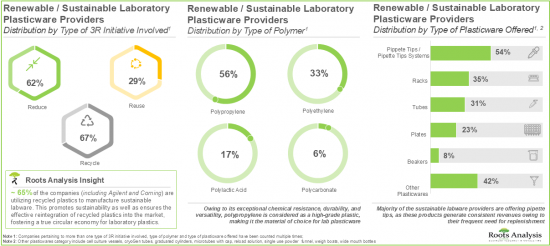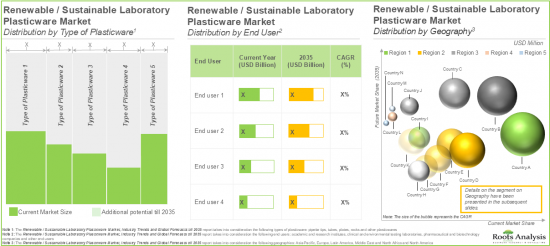Need help finding what you are looking for?
Contact Us
PUBLISHER: Roots Analysis | PRODUCT CODE: 1643957

PUBLISHER: Roots Analysis | PRODUCT CODE: 1643957
Renewable / Sustainable Laboratory Plasticware Market: Industry Trends and Global Forecasts, till 2035 - Distribution by Type of Plastic, Type of Polymer, Type of Plasticware, End User and Geography
PUBLISHED:
PAGES: 157 Pages
DELIVERY TIME: 1-2 business days
SELECT AN OPTION
SUSTAINABLE LABORATORY PLASTICWARE MARKET:
As per Roots Analysis, the global sustainable laboratory plasticware market size is estimated to grow from USD 0.47 billion in the current year to USD 2.69 billion by 2035, at a CAGR of 19% during the forecast period, till 2035.
The opportunity for the sustainable laboratory plasticware market has been distributed across the following segments:
- Type of Plastic
- Bioplastic
- Recycled Plastic
- Other Plastics
- Type of Polymer
- Polyethylene
- Polypropylene
- Polystyrene
- Other Polymers
- Type of Plasticware
- Pipette Tips
- Tubes
RENEWABLE / SUSTAINABLE LABORATORY PLASTICWARE MARKET: GROWTH AND TRENDS
RENEWABLE / SUSTAINABLE LABORATORY PLASTICWARE MARKET: KEY INSIGHTS
1.Several companies across the world are providing a diverse range of eco-friendly plastic labwares for various industrial applications, creating new avenues to reduce dependence on fossil fuels
2.Close to 55% of the sustainable laboratory plasticware providers offer pipette tips / pipette tips systems made from different eco-friendly polymers, while adhering to the principles of the 3Rs (Reduce, Reuse, Recycle).
3.Sustainable / renewable laboratory plasticware market is experiencing significant growth, driven by increasing demand for eco-friendly labware and mounting regulatory pressure on laboratories to adopt sustainable materials.
4.Given the rising adoption of sustainable lab plastics and ongoing innovations in the domain, the renewable / sustainable laboratory plasticware market is anticipated to witness a growth of 19.0% till 2035.
5.The market opportunity is projected to be well distributed across various segments, such as type of plasticware, end users and geography; Asia-Pacific is anticipated to grow at a higher CAGR during the forecast period.
RENEWABLE / SUSTAINABLE LABORATORY PLASTICWARE MARKET: KEY SEGMENTS
Example Players in the Renewable / Sustainable Laboratory Plasticware Market
RENEWABLE / SUSTAINABLE LABORATORY PLASTICWARE MARKET: RESEARCH COVERAGE
KEY QUESTIONS ANSWERED IN THIS REPORT
REASONS TO BUY THIS REPORT
ADDITIONAL BENEFITS
Product Code: RA100520
TABLE OF CONTENTS
SECTION I: REPORT OVERVIEW
1. SCOPE AND OBJECTIVES
- 1.1. Context
- 1.2. Project Objectives
2. RESEARCH METHODOLOGY
- 2.1. Research Assumptions
- 2.1.1. Market Landscape and Market Trends
- 2.1.2. Market Forecast and Opportunity Analysis
- 2.1.3. Comparative Analysis
- 2.2. Database Building
3. MARKET DYNAMICS
4. MACRO-ECONOMIC INDICATORS
SECTION II: QUALITATIVE INSIGHTS
5. EXECUTIVE SUMMARY
6. INTRODUCTION
SECTION III: MARKET OVERVIEW
7. MARKET LANDSCAPE: RENEWABLE / SUSTAINABLE LABORATORY PLASTICWARE PROVIDERS
SECTION IV: COMPANY PROFILES
8. COMPANY PROFILES
SECTION V: MARKET TRENDS AND STRATEGIC TOOLS
9. RENEWABLE / SUSTAINABLE LABORATORY PLASTICWARE MARKET: OVERVIEW OF ONGOING MEGA TRENDS
10. VALUE CHAIN ANALYSIS
SECTION VI: MARKET OPPORTUNITY ANALYSIS
11. MARKET IMPACT ANALYSIS: DRIVERS, RESTRAINTS, OPPORTUNITIES AND CHALLENGES
12. GLOBAL RENEWABLE / SUSTAINABLE LABORATORY PLASTICWARE MARKET
13. RENEWABLE / SUSTAINABLE LABORATORY PLASTICWARE MARKET, BY TYPE OF PLASTIC
14. RENEWABLE / SUSTAINABLE LABORATORY PLASTICWARE MARKET, BY TYPE OF POLYMER
15. RENEWABLE / SUSTAINABLE LABORATORY PLASTICWARE MARKET, BY TYPE OF PLASTICWARE
16. RENEWABLE / SUSTAINABLE LABORATORY PLASTICWARE MARKET, BY END USERS
17. RENEWABLE / SUSTAINABLE LABORATORY PLASTICWARE MARKET, BY GEOGRAPHY
SECTION VIII: OTHER EXCLUSIVE INSIGHTS
18. INSIGHTS FROM PRIMARY RESEARCH
SECTION IX: APPENDIX
19. TABULATED DATA
20. LIST OF COMPANIES AND ORGANIZATIONS
Product Code: RA100520
List of Tables
- Table 6.1 List of Companies Offering Renewable / Sustainable Laboratory Plasticware
- Table 6.2 List of Companies Offering Renewable / Sustainable Laboratory Plasticwares: Information on Type of 3R Initiative Involved, ACT Label, Sustainable Raw Materials of Plastic, Type of Polymer and Type of Plasticware Offered
- Table 19.1 Renewable / Sustainable Laboratory Plasticware Providers: Distribution by Year of Establishment
- Table 19.2 Renewable / Sustainable Laboratory Plasticware Providers: Distribution by Company Size
- Table 19.3 Renewable / Sustainable Laboratory Plasticware Providers: Distribution by Location of Headquarters
- Table 19.4 Renewable / Sustainable Laboratory Plasticware Providers: Distribution by Type of 3R Initiative Involved
- Table 19.5 Renewable / Sustainable Laboratory Plasticware Providers: Distribution by Type of Polymer
- Table 19.6 Renewable / Sustainable Laboratory Plasticware Providers: Distribution by Type of Plasticware Offered
- Table 19.7 Global Renewable / Sustainable Laboratory Plasticware Market, Historical Trends (Since 2020) and Forecasted Estimates (Till 2035) (USD Billion)
- Table 19.8 Global Renewable / Sustainable Laboratory Plasticware Market, Forecasted Estimates (Till 2035): Conservative Scenario (USD Billion)
- Table 19.9 Global Renewable / Sustainable Laboratory Plasticware Market, Forecasted Estimates (Till 2035): Optimistic Scenario (USD Billion)
- Table 19.10 Renewable / Sustainable Laboratory Plasticware Market: Distribution by Type of Plastic (USD Million)
List of Figures
Have a question?


SELECT AN OPTION
Have a question?


Questions? Please give us a call or visit the contact form.


